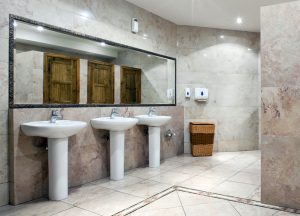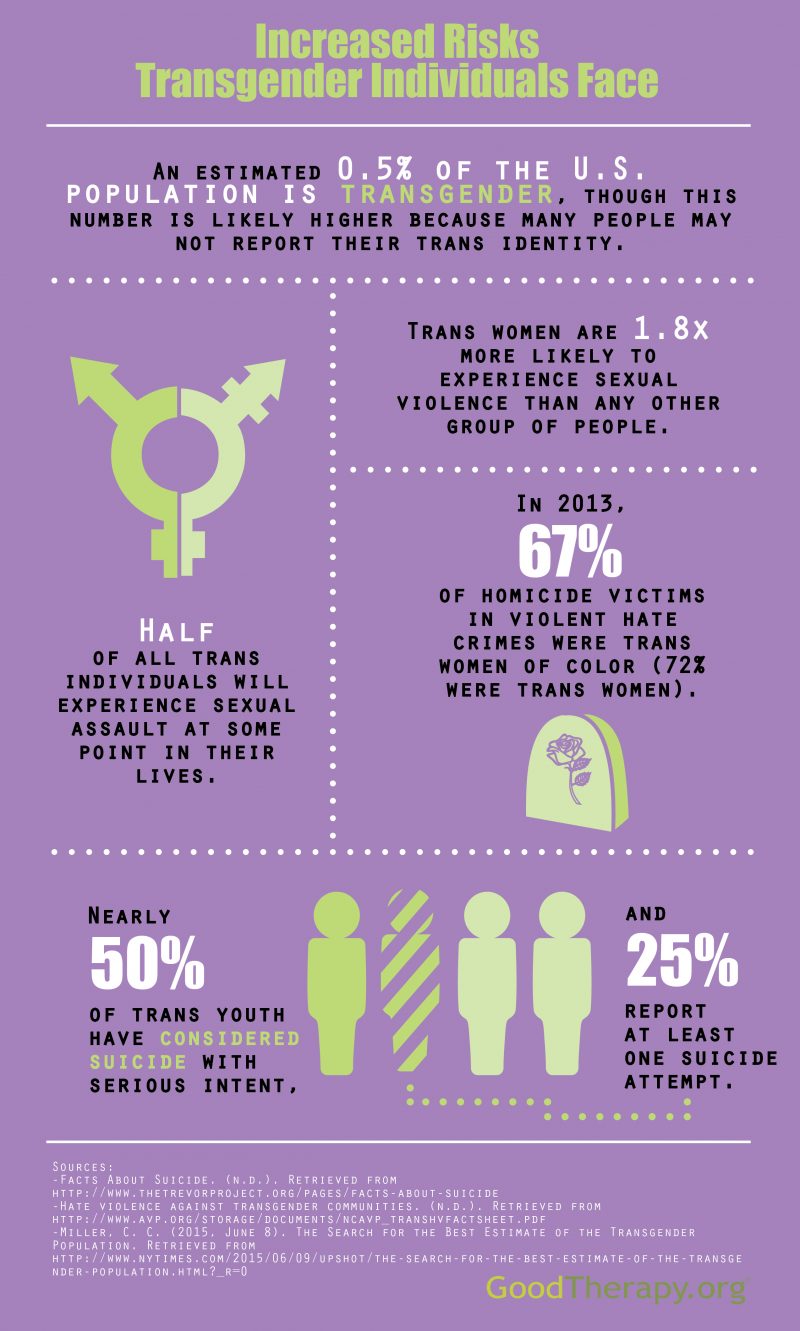 A majority of Americans likely give little thought to using a public restroom beyond where the nearest one is located (and perhaps a fervent wish that the soap dispensers and toilet paper will be stocked). Most people consider the process a simple one: find the facilities, use the facilities, and leave. A bill passed in North Carolina in March, however, along with legislation currently being pursued in Tennessee, South Carolina, Minnesota, and Kansas, is making the process far less simple—and likely distressing—for many.
A majority of Americans likely give little thought to using a public restroom beyond where the nearest one is located (and perhaps a fervent wish that the soap dispensers and toilet paper will be stocked). Most people consider the process a simple one: find the facilities, use the facilities, and leave. A bill passed in North Carolina in March, however, along with legislation currently being pursued in Tennessee, South Carolina, Minnesota, and Kansas, is making the process far less simple—and likely distressing—for many.
The North Carolina law, which requires state residents to use bathrooms and locker rooms corresponding to the sex on their birth certificate, was passed in response to a February ruling in Charlotte that protected the rights of people to use the bathroom matching their gender identity. In February, a similar bill was narrowly defeated in Washington state. The Washington bill would have repealed a December ruling affirming a person’s right to use public facilities correlating to gender identity. For transgender people—individuals whose gender identity does not align with sex assigned at birth—this law creates several challenges.
How Do the ‘Bathroom Laws’ Discriminate?
These new laws—and proposed changes to existing laws—effectively bar trans individuals who have not been able to obtain the documentation necessary to change their gender marker from using the facilities that fit their gender identity. Trans people who have not legally changed their gender marker must break the law—and face fines and/or imprisonment—every time they use the restroom.
Not every trans person will change their gender marker. Some do not choose to, and some are unable to: as of 2015, four states—Tennessee, Ohio, Kansas, and Idaho—did not allow a birth certificate to be changed. Where it is possible to change one’s gender marker, the process is often lengthy, costly, and not easily pursued by some. Many states require gender confirmation surgery before they will issue an updated birth certificate. In some states, individuals who wish to change their gender marker may first be required to socially transition, or live as their gender for a period of time (commonly one year). Living as one’s gender requires using the correct bathroom. North Carolina’s law not only places hardship on trans people by denying them equal rights, it may also prevent them from being able to transition.
Supporters of the law, who claim their intention is not to deny trans people equal rights, appear to be largely united under one argument: Allowing trans people to use the correct bathroom may encourage sexual predators to pretend to be transgender in order to prey on women and girls. This argument is not currently statistically supported, and it discounts the reality that sexual predators who prey on women and girls are not likely to be deterred by a law that, at best, will be difficult to enforce. It also does not consider the experience of trans people, who face extremely high rates of violence and sexual assault: Approximately half of all transgender individuals will experience sexual assault at some point in their lives.
Statistics gathered from national surveys show the perpetrators of sexual assault are predominantly male. Some female supporters of these “bathroom laws,” many of whom have survived a rape or other sexual assault, support the laws for this reason, saying they do not feel comfortable sharing a bathroom with men. While these feelings are certainly valid, they serve as a sweeping misgender of all trans people: Trans women are not men, regardless of the anatomy they were born with, and the trans men who will be forced to use women’s bathrooms are men. According to the National Coalition of Anti-Violence Programs (NCAVP), trans women are almost twice as likely to experience sexual violence as any other group of people, trans or otherwise, and thus may also feel uncomfortable sharing a bathroom with men.
When in public spaces, trans people frequently face discrimination, stigma, and harassment. They might be misgendered or otherwise invalidated. All of these can contribute to feelings of shame, gender dysphoria, low self-esteem, depression, or anxiety.Cisgender women (women who are not trans) greatly outnumber the entire trans population, and many people have argued cis women, as the majority, should not be placed in a position that makes them uncomfortable to accommodate relatively few trans people. (According to estimates based on survey data, roughly 0.5% of the population is trans, though the actual number is likely higher.) Yet many people may have already shared a bathroom with a trans person without realizing it. Others who shared a bathroom with a person they thought was trans and felt uncomfortable might consider asking themselves why they felt that way and whether the other person’s gender really matters.
Most people, trans, cis, intersex, or otherwise identified, have no desire to remain in a public bathroom any longer than necessary, and the National Task Force to End Sexual and Domestic Violence Against Women reports no increase in sexual violence or public safety issues in jurisdictions that have nondiscrimination laws. People who feel uncomfortable may wish to examine whether their discomfort (which is not the same as being in danger) is linked to rational fears of sexual assault or to the fear of something they do not understand and whether eliminating those moments of discomfort come at the cost of protecting the safety of another human being.
Many supporters of the bill maintain they do not view transgender people as potential sexual predators. Regardless, excluding trans people from the correct bathrooms is still likely to send the message that their identity is invalid, that they are not welcome as part of the community. These laws, which may suggest the safety and comfort of trans people is not as important as that of cis people, could be seen as discriminatory toward a minority group at risk while also failing to address the root cause for concern: sexual assault is common and might occur anywhere, among any population.
Trans People Often Face Adversity in Public Spaces
When in public spaces, trans people frequently face discrimination, stigma, and harassment. They might be misgendered or otherwise invalidated. All of these can contribute to feelings of shame, gender dysphoria, low self-esteem, depression, or anxiety. Many trans people may dread going out in public, especially alone. When public spaces cannot be avoided, they might instead avoid situations where they could be challenged, such as using public restrooms.
All people deserve a restroom they can use safely, without fear of harassment or violence. According to the NCAVP and Rape Response Services National Statistics, trans people face high rates of homicide, sexual assault, and violence. Trans people of color are at even higher risk: in 2013, 67% of hate violence homicide victims were trans women of color. Preventing trans people from using the facilities they feel most comfortable in may make it necessary for them to put themselves at greater risk (and also possibly out themselves as trans) in order to use the restroom.
The backlash to these rulings, and other similar rulings across the country, has been considerable, especially as transgender students across the country fight similar discriminatory measures for equal access to bathrooms and locker rooms in public schools. Critics point out not only are these laws likely to cause humiliation and distress, they clearly violate the Civil Rights Act.
Several entertainers and organizations have boycotted trips to North Carolina in support of transgender rights, and the Obama administration issued a decree in May 2016 ordering all public schools to allow trans students access to facilities corresponding to their gender identity rather than sex assigned at birth. A number of school districts across the country have refused to accept the decree, citing concerns about boys in girls’ locker rooms and the discomfort of female students.
What these school districts do not seem to address is the discomfort and distress of the transgender students who are required to either use the wrong facilities or change alone in the nurse’s office or other designated facility. In either outcome, these students may face prejudice, harassment, and abuse from other students as well as feelings of shame and isolation, among other issues. Many trans students report avoiding the restrooms entirely, an action that may affect emotional well-being as well as physical health.
Proposed Solutions to Discriminatory Bathroom Policies
Awareness of trans issues is increasing across the nation, and many young trans people have the support and encouragement of their families, but many still do not. Along with the likelihood of discrimination and ostracism at the hands of peers or family members, trans teens and preteens also face the onset of puberty and the emergence of physical features and bodily changes that may lead to gender dysphoria or exacerbate existing feelings. Many teens who wish to take hormones and begin transitioning cannot start this process without parental support. Some have the support of a mental health professional, but many lack even that.
School-level legislation that further denies the identity and existence of transgender youth may contribute to depression, anxiety, and other mental health concerns. It may also increase the risk of suicide in this population, which is already high. Among trans youth, nearly 50% have considered suicide with serious intent, and 25% report at least one attempt. The rates of suicide and other mental health concerns experienced by transgender youth are shown to decrease when they receive acceptance and support.
All-gender restrooms, already prevalent in many countries, may be the logical destination of progress, as gender becomes more understood and the male-female binary is recognized to be an outdated concept.Some point to all-gender or family bathrooms as a solution. While some trans individuals might use these restrooms when they are available, as any other person might, being allowed to only use these restrooms can still be exclusionary and may contribute to feelings of dysphoria. Others say creating bathrooms exclusively for transgender people to use would be an ideal solution, but as Attorney General Loretta Lynch pointed out in a statement announcing a federal lawsuit against North Carolina, “Not so long ago … states had signs about restrooms … keeping people out based upon a distinction without a difference.” Others have similarly drawn comparisons from the bathroom debate to the Jim Crow laws segregating people of color.
Some organizations and companies, such as Target, have responded to these laws by vocalizing their support of trans people with inclusive policies encouraging customers and employees alike to use the restroom that aligns with their gender identity. At Cooper Union College in New York, student activists removed all gendered signs on the bathroom. New placards read “restroom with urinal and stalls” and “restroom with only stalls.” Other colleges have similarly implemented all-gender restrooms with the goal of making public spaces safe and accommodating for everyone. All-gender restrooms also serve to welcome non-binary individuals, who might not feel comfortable in either men’s or women’s restrooms.
Everyone Has the Right to Safety
Many trans people across the nation still cannot use the restroom without facing threats to their personal safety. A woman in Washington, D.C. was assaulted by a security guard when she tried to use the restroom at a grocery store, and students in one North Carolina school district are now allowed to bring pepper spray to campus, which one board member claims may be a “valuable tool” for females who use the restroom on campus. Other schools encourage students to report their transgender classmates if they use the “wrong” bathroom.
Such instances of harassment and prejudice against trans people are likely to do little for the community other than foster fear and transphobia. Even if legislators and others who do not support bathroom use according to gender identity claim they are not targeting transgender people, these measures may invalidate the identity of trans people and perpetuate stigma. They also do not address the high rates of assault and violence trans people experience. Safe public restrooms are a necessity for all, and trans individuals prevented from using the correct restroom may not only face threats to their bodily safety, but also diminished mental and emotional well-being due to stress, anxiety, shame, and dysphoria.
All-gender restrooms, already prevalent in many countries, may be the most logical destination of progress, as gender becomes more understood and the male-female binary is recognized to be an outdated concept. Until then, allowing individuals to choose a restroom based on their gender—and perhaps caring a bit less about who is using what restroom—may be the best solution to an issue that was never really a problem.
References:
- Banchiri, B. (2016, February 23). Charlotte passes transgender rights law: Will North Carolina let it stand? Retrieved from http://www.csmonitor.com/USA/Politics/2016/0223/Charlotte-passes-transgender-rights-law-Will-North-Carolina-let-it-stand
- Bellware, K. (2014, July 18). Gender-neutral bathrooms are quietly becoming the new thing at colleges. Retrieved from http://www.huffingtonpost.com/2014/07/18/gender-neutral-bathrooms-colleges_n_5597362.html
- Borrello, S. (2016, April 22). Sexual assault and domestic violence organizations debunk ‘bathroom predor myth.’ Retrieved from http://abcnews.go.com/US/sexual-assault-domestic-violence-organizations-debunk-bathroom-predator/story?id=38604019
- Carollo, L. (2016, April 25). What happened when I tried to comply with North Carolina’s new bathroom law. Retrieved from http://www.vox.com/2016/4/25/11490498/north-carolina-bathroom-law-transgender
- Changing birth certificate sex designations: State-by-state guidelines. (2015, February 03). Retrieved from http://www.lambdalegal.org/know-your-rights/transgender/changing-birth-certificate-sex-designations
- Cobb, J. (2016, May 30). Opening doors. The New Yorker. Retrieved from http://www.newyorker.com/magazine/2016/05/30/north-carolinas-retrograde-step
- Connelly, J. (2016, February 10). ‘Bathroom bill’ aimed at transgender persons fails in state Senate. Retrieved from http://www.seattlepi.com/local/politics/article/The-bathroom-bill-blocking-toilet-use-by-the-6821841.php
- Facts about suicide. (n.d.). Retrieved from http://www.thetrevorproject.org/pages/facts-about-suicide
Hate violence against transgender communities. (n.d.). Retrieved from http://www.avp.org/storage/documents/ncavp_transhvfactsheet.pdf - Levin, S. (2016, May 12). Obama orders public schools to allow transgender students access to restrooms. Retrieved from http://www.theguardian.com/society/2016/may/13/obama-public-schools-transgender-access-restrooms
- Lopez, G. (2016, April 18). 9 questions about gender identity and being transgender you were too embarrased. Retrieved from http://www.vox.com/2015/4/24/8483561/transgender-gender-identity-expression
- Lowder, J. B. (2016, April 27). Breitbart proves what we already knew: Trans women are not bathroom predators. Retrieved from http://www.slate.com/blogs/outward/2016/04/27/breitbart_helpfully_shows_trans_women_are_not_bathroom_predators_cis_men.html
- Miller, C. C. (2015, June 08). The search for the best estimate of the transgender population. The New York Times. Retrieved from http://www.nytimes.com/2015/06/09/upshot/the-search-for-the-best-estimate-of-the-transgender-population.html?_r=0
- Ng, A. (2016, May 11). North Carolina schools let students bring pepper spray to class–in case transgender students use bathrooms. Retrieved from http://www.nydailynews.com/news/national/n-schools-students-bring-pepper-spray-class-article-1.2633430
- Pearson, M. (2016, May 10). AG Loretta Lynch moves into spotlight with NC bathroom law speech. CNN. Retrieved from http://www.cnn.com/2016/05/10/politics/loretta-lynch-north-carolina
- Rape Response Services National Statistics. (n.d.). Retrieved from http://www.rrsonline.org/?page_id=944
- Redden, M. (2016, March 29). New York college moves to strip gender markings from all bathrooms. The Guardian. Retrieved from http://www.theguardian.com/world/2016/mar/29/gender-bathrooms-cooper-union-college-new-york
- Tan, A. (2016, May 19). Security guard arrested after allegedly assaulting transgender woman trying to use women’s bathroom. ABC News. Retrieved from http://abcnews.go.com/US/security-guard-arrested-allegedly-assaulting-transgender-woman-womens/story?id=39227006
- Transgender Bathroom Hysteria, Cont’d. (2016, April 18). Retrieved from http://www.nytimes.com/2016/04/18/opinion/transgender-bathroom-hysteria-contd.html?_r=4&mtrref=undefined&gwh=459A290B6C63807CACCEAADDE4A5626A&gwt=pay&assetType=opinion
- Understanding the Perpetrator. (n.d.). Retrieved from https://sapac.umich.edu/article/196

The preceding article was solely written by the author named above. Any views and opinions expressed are not necessarily shared by GoodTherapy.org. Questions or concerns about the preceding article can be directed to the author or posted as a comment below.


 Bullying, Rejection May Be Factors in Transgender Suicide Rate
Bullying, Rejection May Be Factors in Transgender Suicide Rate Best of 2015: GoodTherapy.org's Top 10 Transgender Resources
Best of 2015: GoodTherapy.org's Top 10 Transgender Resources How to Support a Transgender Friend or Family Member
How to Support a Transgender Friend or Family Member

Please fill out all required fields to submit your message.
Invalid Email Address.
Please confirm that you are human.
Leave a Comment
By commenting you acknowledge acceptance of GoodTherapy.org's Terms and Conditions of Use.